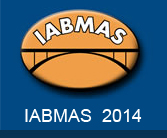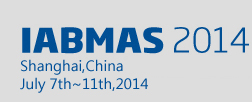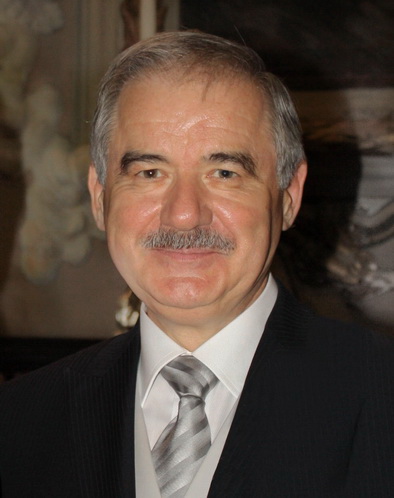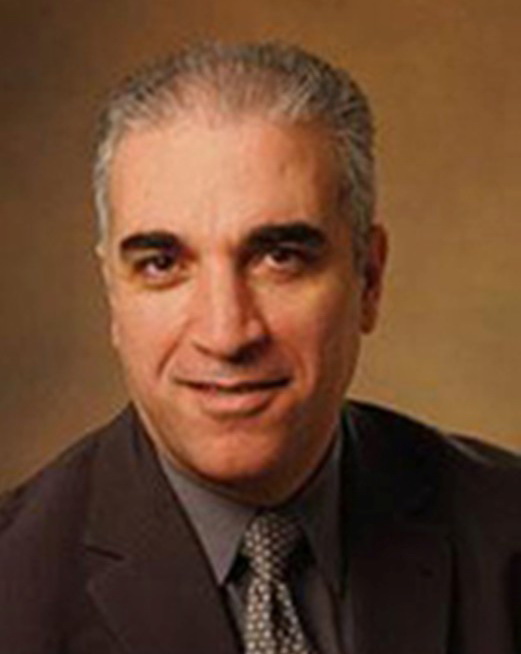|
PROGRAM
|
MS 1 Data Management & Analysis for Bridge Monitoring Results In the bridge health monitoring system, it produces a huge amount of monitoring data for every day, every month and every year. It becomes also an important thing that how to detect damages from such huge number of monitoring data, that is a big challenge for analysis to discover the damage information of a target bridge. Furthermore, there are not only many kinds of sensor data, but also many undetermined factors in the system, such as ever-changing climate condition, severe noise interference, etc. Then we propose a Mini-Symposium on data management & analysis related to bridge health monitoring data from various points of view.
MS 2 Life-Cycle Assessment of Bridge Performance in an Aggressive Environment During the last decades, the amount bridges suffering from various damage mechanisms like corrosion and fatigue has significantly increased. The aim of this Mini-Symposium is to attract state-of-the-art papers that deal with the use of advanced computational and/or experimental techniques for evaluating the life-cycle bridge performance in an aggressive environment. For bridges located in an aggressive environment, multiple environmental and mechanical stressors lead to deterioration of structural performance. Such deterioration will reduce the service life of bridges and increase the life-cycle cost of maintenance actions. This Mini-Symposium covers current theoretical and experimental efforts made in the assessment and future prediction of performance, maintenance and strengthening of bridges, and life-cycle design of deteriorated bridges. The following main topics are addressed: - Long-term deterioration model of bridge performance - Life-cycle analysis of bridges based on reliability approach - Visual inspection or advanced structural health monitoring techniques - Related topics with laboratory or field experiments on aging ridges Mini-Symposium organized on behalf of the SEI/ASCE Technical Council on Life-Cycle Performance, Safety, Reliability and Risk of Structural Systems, Task Group 1 on Life-Cycle Performance of Structural Systems under Uncertainty. http://www.asce.org/sei/Content.aspx?id=23622324218
MS 3 Bridge Loading – Measurement and Modelling Loading is the most variable term in the structural reliability problem. Since resistance modelling is fairly well understood, in the assessment of existing bridges in particular, the accurate estimation of loading can obviate or reduce the need for replacement and rehabilitation measures, potentially offering bridge owners (and society) enormous savings. This mini-symposium will examine all forms of loading for pedestrian, highway, and railway bridges, including, but not limited to, long- and short-span bridges, vehicle and traffic modelling and measurements, dynamics, statistical analysis, earthquakes, pedestrians and non-linear modelling methods. Those involved in the measurement and modelling of loading, both static and dynamic and the calibration of theoretical models, are particularly encouraged to submit their work for presentation in this mini-symposium.
MS 4 Bridge Performance Assessment and Prediction using Monitoring  Alfred Strauss University of Natural Resources and Life Sciences Vienna, Austria Aging, degradation, increasing loads, and hazards lead to increasing risk of the bridge infrastructure. In this context, bridge assessment and monitoring concepts become increasingly important in the intervention planning (e.g., maintenance, repair, rehabilitation, replacement). Nevertheless, there is still a strong demand for the development and efficient use of novel techniques for monitoring and assessment of bridges. The objective of this Mini-symposium is to highlight recent developments in monitoring the bridge performance and prediction.
MS 5 Design and Management of Highway and Railway Brazilian Bridges Nowadays Brazil is facing many challenges in order to improve its transportation infrastructure. In this case, existing and new highway and railway bridges are the subject of research in terms of assessment of the structural behavior. The aim of this Mini-Symposium is to assemble papers that deal with the design and management of highway and railway Brazilian bridges. Advanced computational models, assessment the fatigue life of existing bridges under real traffic, dynamic analysis, deterioration models and prediction of material properties are some topics which will be discussed.
MS 6 Research and Applications in Bridge Health Monitoring This mini-symposium is the continuation of a successful mini-symposium conducted in IABMAS 2008 in Seoul, Korea, 2010 in Philadelphia, USA and 2012 Stresa, Italy. Bridge health monitoring (BHM) is typically used to track and evaluate performance, symptoms of operational incidents, anomalies due to deterioration and damage, as well as health during and after extreme events. It is possible to capture seasonal and environmental changes not readily apparent from intermittent tests. Bridge health monitoring, which is a special case of structural health monitoring, can be expected to integrate sensing technologies, analysis methods and information technology for infrastructure management. There are numerous real-life BHM applications around the world. New advances in sensor and information technologies and the wide use of the Internet make BHM a promising technology for better management of bridges. Large-scale applications have been presented at a number of specialty conferences and workshops. In spite of the recent activity in this area and the successes achieved, this technology is not gaining acceptance by bridge owners and practicing engineers. We need to close the gap between theory and practice. There are many challenges remaining that must be overcome for successful BHM applications. As a result, there is still a lot of research to be conducted and then demonstrated before routine applications of BHM can be expected to take place. This mini-symposium if focusing particularly on the research needs for BHM systems and benchmark studies, and integration of BHM analysis methods for decision-making. The mini-symposium covers the following topics and other related topics in the broad area of "Research and Application for Bridge health Monitoring." - Long term monitoring applications of bridges - Management and maintenance oriented monitoring applications - Research in reliability based bridge health monitoring - Research in local and global monitoring for bridges - Benchmark studies for collective research - Research in novel technologies such as GPS, computer vision, novel materials, new sensing applications
MS 7 Vulnerability Modeling and Risk Assessment of Bridges Subjected to Multiple Threats Bridges face multiple threats throughout their lifetime, including natural hazards, deterioration, and heightened truck loads. This mini-symposium brings together academics, researchers, and practitioners to address issues central to vulnerability modeling, risk assessment and mitigation for bridges subjected to multiple threats. Such threats may be cumulative (e.g. corrosion deterioration or scour) or pulse type (e.g. earthquakes or impact); and may occur independently or concurrently. Threats are different in terms of their frequency of occurrence, impacts on bridge behavior, and associated return period used for current codified design. Central issues addressed include multi-threat reliability assessment and load combination, along with the development of theoretical frameworks and case study illustrations.
MS 8 Management and Strengthening of Bridges - An Australian Perspective 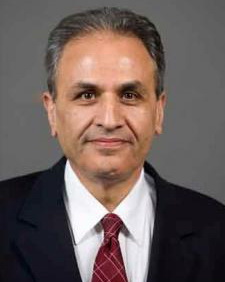 Riadh Al-Mahaidi Swinburne University of Technology Hawthorn, Victoria, Australia With some of the worlds heaviest legal vehicle loads, Australia is constantly pushing the boundaries of bridge technology to keep freight vehicles moving and to maintain its network of roads and bridges in a safe and durable condition. The Australian road network has a complex mix of bridges, from timber and masonry bridges built in the 1800's to modern steel box girders. Australia relies heavily on road freight for its economic prosperity and the freight industry is constantly campaigning for high mass vehicles to be allowed on the network. This session will showcase how Australian academics and practitioners are meeting this challenge.
MS 9 Dangerous Bridge Details After a structural failure occurs, investigations, surveys and analyses try to explain what happened and try to find the causes of the partial or total collapse. Aim of these studies is to identify the mistake, or the sequence of mistakes, which led to an unsuccessful performance and to highlight the elements which can contribute to avoiding the same errors in the future. Failure during construction and failure due to impacts, fire and explosions or to seismic activity are the most frequent cases reported in Literature. However, a high percentage of failures happens in service without any external actions intervening. Most of such failures are due to the local rupture of a critical detail. - Shortcomings in identifying the actual mechanical behaviour (disregarded local instability, ignorance of severe diffusive phenomena, underestimation of temperature or of time-dependant effects); - Shortcomings in modelling (wrong hypotheses, which lead to a non representative model of the actual structure; insufficient refinement in modelling techniques; the modelling on the sale level of mechanical behaviours which develop at different scales; ingenuous assumptions about the material constitutive laws); - Poor drawing of structural details in critical areas (stress concentration effects; insufficiently bonded reinforcement; reinforcements which cause void thrusts), where the level of performance is lower than that required by analytical results. - ageing of the structure, causing material ablation and/or local corrosion. This Mini-Symposium on “Dangerous Bridge Details” is aimed to calling for contributions in the fields of computational mechanics and structural assessment, focussed on modelling and interpretation of failures due to the fault of apparently secondary structural elements. The argument is wide and fruitful contributions are expected, involving general theoretical approaches, specialized theories and modelling, exam and explanation of case studies concerning bridges, buildings, industrial plants, offshore structures and nuclear power plants.
MS 10 Life-time perspective for design and maintenance of short, medium, and long-span bridges Infrastructure systems constitute a major part of the national investment of many countries and are critical for the mobility of their societies as well as their economic growth and prosperity. Transportation infrastructure systems, including bridges, are considered assets that should be designed, protected and properly managed. Yet, the degree of rapid deterioration and the risk of exposure to natural and man-made disasters are dangerously high. According to the U.S. National Bridge Inventory's (NBI) 2011 data, 24% of the 605,086 bridges in USA need replacement or major repairs. There is a need to develop sustainable design concepts, efficient assessment tools, and reliable technologies for the evaluation of numerous long-standing bridges. As the long-span bridges are also increasing, the extended lifetime is also demanding when considering the return of initial investment. Accordingly, the lifetime perspective for design and management of bridges should be set up in a consistent strategy. Considering these issues, the main goal of this Mini-Symposium is to help develop guidelines for the design, evaluation, assessment, and load rating of bridges by incorporating field-testing, structural health monitoring, and probabilistic methods. The Mini-Symposium will include sessions that will provide a platform for researchers from leading countries to discuss and compare various methodologies that were adopted by their respective transportation agencies and to enhance future collaboration on this subject. The current state-of-the-art and technological advances from design to management will be presented and discussed for the short, medium and long-span bridges.
MS 11 MAINLINE - Maintenance and Management of Railway Bridges Growth in demand for rail transportation across Europe is predicted to continue. Much of this growth will have to be accommodated on existing lines that contain old infrastructure. This demand will increase both the rate of deterioration of these elderly assets and the need for shorter line closures for maintenance or renewal interventions. However, interventions on elderly infrastructure will also need to take account of the need for lower economic and environmental impacts. This means that new interventions will need to be developed. In addition tools will need to be developed to inform decision makers about the economic and environmental consequences of different intervention options being considered. MAINLINE is a European railway project funded under the 7th Framework Programme and its consortium comprises 19 partners from 11 different countries. It is a three-year project that started in October 2011. MAINLINE is co-ordinated by UIC - International Union of Railways. The objective of the project is to develop methods and tools contributing to an improved railway system by taking into consideration the whole life of specific infrastructure - tunnels, bridges, track, switches, earthworks and retaining walls. MAINLINE will: - facilitate the utilisation of improved assessment and life extension without increasing risk - improve existing knowledge on damage and deterioration mechanisms in order to reduce significantly their effect on asset performance - identify and implement new cost effective replacement/renewal construction methods and logistics - identify and compare new surveying and monitoring technologies - develop methods to determine the whole life environmental and economic impact.
MS 12 Life Cycle Management of Infrastructures Infrastructure is essential to the social and economic development of a city and to the quality of life of the people living in the city. However, the increasing stocks of public infrastructure and serious deterioration of infrastructure systems in many cities present great financial, safety, technical and operational challenges to government organizations in charge of public infrastructure development and management. It is recognized that an integrated whole life-cycle design and management strategy needs to be developed in order to meet these challenges. This includes that a coherent life cycle management strategy, various deterioration mechanisms of reinforced/prestressed concrete and steel structures have to be examined then, service life prediction models must be developed based on the component and system deterioration mechanisms. For considering whole life-cycle design and management of infrastructures, some life-cycle cost analysis models are also needed to be reviewed and developed. In addition, Markov decision process must be enhanced for the purpose of modeling the change of condition index to optimize annual management actions and annual budget allocation, subject to various types of constraints. This Markov-based optimization model would provide a useful tool for life-cycle cost analysis and management in a network of many bridge infrastructures. This mini-symposium will be focused on the above three areas with each session addressing a particular issue. Session one is on infrastructure deterioration mechanics and service life prediction; session two is on life cycle performance and life cycle costing; and session three is focused on optimization and modeling of infrastructures. The mini-symposium with its 15 papers will provide the current state of the knowledge in this whole area and will form the basis for the future development of whole life-cycle design and management strategies for highway infrastructures.
MS 13 Performance-based Detection, Evaluation and Strengthening of Existing Bridges  Eugen Brühwiler Swiss Federal Institute of Technology in Lausanne (EPFL) Lausanne, Switzerland In the 21st century, traffic volume, loads and speeds on existing bridges have increased due to harder competition to provide fast and sufficient transportation service in the world. Bridge owners and bridge engineers are paying more attention to the actual safety, remaining service life, maintenance intervals and the ability to increase loads of such infrastructure, considering to save limited resource and environmental protection, so it is necessary to study innovative performance-based detection, evaluation and strengthening methodologies and techniques to reduce the life-cycle cost, achieve economical maintenance and extend the sustainable service life of existing bridge structures. The new generation performance-based bridge maintenance should pay more emphasis on safety, durability, low carbon releasing, energy saving, reuse of construction waste, and whole life economy. This mini-symposium focuses on advanced technologies for performance-based detection, evaluation and strengthening of existing bridges. The objective of this symposium is to provide a forum for presenting the current status of performance-based detection techniques, assessment methods and reinforcement technologies for bridge maintenance.
MS 14 Development and challenge of bridge monitoring and maintenance in China  Na Li CCCC Highway Consultants CO., Ltd Beijing, China
With the rapid development of transportation demand, a lot of magnificent bridges were built in China in the past twenty years. Due to various causes, such as environment deterioration, management inefficiency and construction quality problems, a massive number of newly constructed bridges are now facing the problems of normal serviceability. Under this circumstance, it is very urgent for Chinese bridge engineers and scholars to seek for effective monitoring and maintenance methods to ensure the safety of the bridges recent years. The purpose of this Mini-symposium is presenting the recent technical achievements and major problems in bridge monitoring, inspection, repair and strengthening in China. It will explore future technology focus and developing direction in this field as well. |
